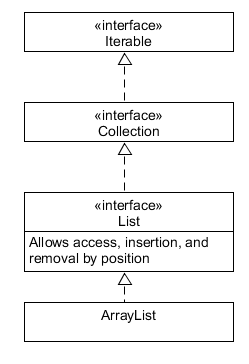ArrayList, Collection,
ConcurrentSkipListSet, HashSet, Iterable, LinkedHashSet, LinkedList,
List, PriorityQueue, Queue, Set, SortedSet, Stack, and TreeSet.
These are the main ones; we skipped most of the concurrent/blocking
structures, and some special-purpose ones. Note that the map ADT
(AbstractMap, TreeMap, and HashMap) aren’t connected to the others:
they form their own hierarchy that is so close to that for Sets, that
it isn't worth you writing (although we expect you to know and use
Maps). Hints: 1. Most relationships are that of an
interface extending or a class implementing an interface - use
dotted lines there. There is only one example of inheritance -
use a solid arrow there. 2. A class may implement multiple interfaces -
there is one example of that here. 3. Here is the top of the hierarchy
- copy this pic and skim each of these interfaces and class
in the javadoc to get started. 4. I just started with the ArrayList
javadoc and looked for the required classes/interfaces (finding
Iterable, Collection, and List), and then looked at each of
those
to see which one was a subinterface and which was a superinterface. 5.
Feel free to do this with a partner, but you must each submit one
copy.

- Is it true that log2(n) is θ(log10(n))? Justify your answer. (Hint: use one of the logarithm formulas!)
- Is it true that 10n is θ(2n)? Justify your answer.
-
for (int i=0; i <= n+2; i++) {
for (int j=0; j < n * n; j++) {
sum++;
}
} -
for (int i=0; i < n; i++) {
for (int j=i; j < n; j++) {
sum++;
}
} - You may assume that n is a power of 2.
for (int i = n; i > 0; i /= 2) {
for (int j = 0; j < i; j++) {
sum++;
}
} -
for (int i=n; i >= 1; i = i / 2) {
sum++;
}
(10 points) Weiss Exercise 5.30 [5.23]. Note that your
method is
supposed to efficiently search the sorted (increasing) array
a of integers, looking for an integer i
for which a[i] == i and return
true if and only if there is such an i.
You may assume that the array has no duplicate entries,
and therefore is strictly increasing. I.e. a[j-1]
< a[j] for all j
with 0 < j < a.length. You may
not assume that all of the integers
in the array are non-negative, because then the problem would be
boring.
Show your algorithm and the results of your analysis. Obviously you should try to come up with an efficient algorithm; some of the credit for this problem will be based on your algorithm's efficiency. (Think about it carefully—is O(N) "efficient" for this task? Anyone can write a loop from 0 to a.length.)
For Your Consideration
These problems are for you to think about and convince yourself that you could do them. It would be good practice to actually do them, but you are not required to turn them in.
-
Weiss Exercise 6.5 [6.5]. (You may have to come back to it a few times before you figure out what to do.) Here is a more detailed explanation:
The goal of this problem is to implement a collection data type that provides three operations and does them efficiently:
push(obj); // adds obj to the collection.
obj = pop(); // removes and returns the most recently-added object.
obj = findMin(); // returns the smallest object (assume that all
// of the objects in the collection are Comparable).A single stack can do the first two operations in constant time, but not the third. But if our implementation uses TWO stacks to represent a collection, it is possible to do each of the three operations in constant time. Is should be obvious that our new data structure’s
pushmethod will have to do more work (than thepushoperation for an ordinary stack would have to do) in order forfindMinto also be a constant-time operation. All you need to do is show the code for the three operations. You may assume that there is already aStackclass that has its ownpush,pop, andtopmethods. The code for each of the three methods that you must provide is short. We hope that by making things a bit more specific, it will make it easier for you to get started on this problem.To further assist you in understanding this problem, here is a framework in which your answers could go: A class declaration with stubs for the three methods you are supposed to write. Each of those methods should be constant time (no loops or recursion)
public class StackWithMin<E> {
// TODO: Give these two stacks names indicating what they are used for:
private Stack<E> stack1, stack2;
public StackWithMin() {
this.stack1 = new Stack<E>();
this.stack2 = new Stack<E>();
}
public void push(E element) { /* TODO: fill in the details */ }
public E pop() {/* TODO: fill in the details */ }
public E findMin() {/* TODO: fill in the details */ }
} - Weiss exercises 6.26(a)(b), 6.27(a)(b), 6.28(a)(b) [6.12(a)(b), 6.13(a)(b), 6.14(a)(b)]. No implementation required; just the algorithm and analysis.